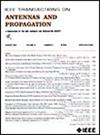一种基于导波激励结构的低交叉极化双极化可重构智能表面
IF 5.8
1区 计算机科学
Q1 ENGINEERING, ELECTRICAL & ELECTRONIC
引用次数: 0
摘要
本文提出了一种低交叉极化水平的导波启发双极化可重构智能表面(RIS)。所设计的RIS单元主要由一个金属贴片、两个180°混合耦合器和两个从上到下的相位调制电路组成。顶部装有四条寄生条的方形金属贴片用于将入射电磁波和导波相互转换;采用中间180°混合耦合器差分馈送方形贴片,大大降低了交叉极化水平;底部相位调制电路通过施加不同的偏置电压来调制导波的相位。所设计的单晶片在4.9 GHz工作频率下可实现连续全相位调制,反射幅值波动范围小于0.8 dB,交叉极化电平小于−27 dB。作为验证,制作了一个由$8 × 8$单元胞组成的RIS样品并进行了测量,测量结果与模拟结果一致。通过现场可编程阵列(FPGA)为每个单元提供不同的偏置电压,反射波束可以在4.9 GHz下在±60°的二维范围内扫描。所提出的RIS在RIS辅助无线通信系统中具有很大的应用潜力。本文章由计算机程序翻译,如有差异,请以英文原文为准。
A Dual-Polarized Reconfigurable Intelligent Surface With Low Cross-Polarization Based on Guided-Wave Inspired Structure
In this communication, a guided-wave inspired dual-polarized reconfigurable intelligent surface (RIS) with low cross-polarization level is proposed. The designed RIS unit cell is mainly composed of a metal patch, two 180° hybrid couplers, and two phase modulation circuits from top to bottom. The top square metal patch loaded with four parasitic strips is used to convert the incident electromagnetic wave and guided-wave to each other; the middle 180° hybrid couplers are used to differentially feed the square patch to greatly reduce the cross-polarization level; the bottom phase modulation circuits are used to modulate the phase of guided-wave by applying different bias voltages. The designed unit cell can achieve a continuous full phase modulation, with a reflection amplitude fluctuation range of less than 0.8 dB and a cross-polarization level below −27 dB at the working frequency of 4.9 GHz. As validation, an RIS sample consisting of $8\times 8$ unit cells is fabricated and measured, and the measured results are in agreement with the simulated results. By providing different bias voltages to each unit cell through a field programmable array (FPGA), the reflected beam can scan in a 2-D range of ±60° at 4.9 GHz. The proposed RIS has great application potential in the RIS-assisted wireless communication systems.
求助全文
通过发布文献求助,成功后即可免费获取论文全文。
去求助
来源期刊
CiteScore
10.40
自引率
28.10%
发文量
968
审稿时长
4.7 months
期刊介绍:
IEEE Transactions on Antennas and Propagation includes theoretical and experimental advances in antennas, including design and development, and in the propagation of electromagnetic waves, including scattering, diffraction, and interaction with continuous media; and applications pertaining to antennas and propagation, such as remote sensing, applied optics, and millimeter and submillimeter wave techniques

 求助内容:
求助内容: 应助结果提醒方式:
应助结果提醒方式:


